 |
||||||
"Firewire is dead, long live USB." Perhaps. I'm no oracle. What is not in question? USB has arrived in earnest. The perhaps most salient proof thereof occurred in Esoteric's exhibit (which incidentally used Matthias Ruff's Avantgarde Acoustic horns -- good for continuity -- for which Esoteric is the Japanese importer). |
||||||
 |
||||||
Esoteric's new SA-50 features a 32-bit Asahi Kasei EMD AK4392 D/A converter (one balanced chip per channel) and a reclocker for a second digital device. It also sports the company's VOSP transport (on the subject of which, Audio Aero, dCS, EMM Labs, Mark Levinson and Playback Design all showed transports or one-box players with one of Esoteric's overbuilt mechanical sleds; I somehow suspect this included Luxman but could obtain no confirmation). |
||||||
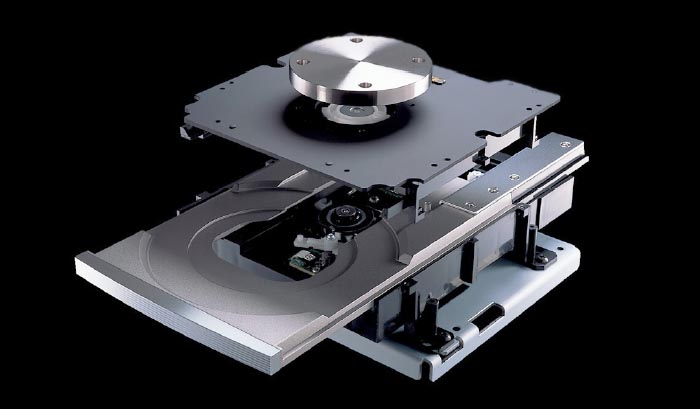 |
||||||
The VOSP Vertically-aligned Optical Stability Platform evolved from Esoteric's P-01 and P-03 transports and ensures that the laser's optical axis is always at the center of the data track for optimal reading. "With VOSP implementation, no-off axis error correction is needed because no off axis data tracking is allowed." Digital conversion options for the SA-50 deck include DSD to 32-bit PCM conversion for SACD and PCM to DSD conversion for Redbook CD. Naturally, SACD can also be processed natively and oversampling is selectable from x2/88.2kHz and x4/176.4kHz. Filter modes include FIR and short delay. |
||||||
 |
||||||
The real excitement for end users occurs on the business end where one finds three digital inputs (coax, optical and USB). They allow use of the SA-50 as standalone upsampler, D/A converter or digital preamp with volume control. |
||||||
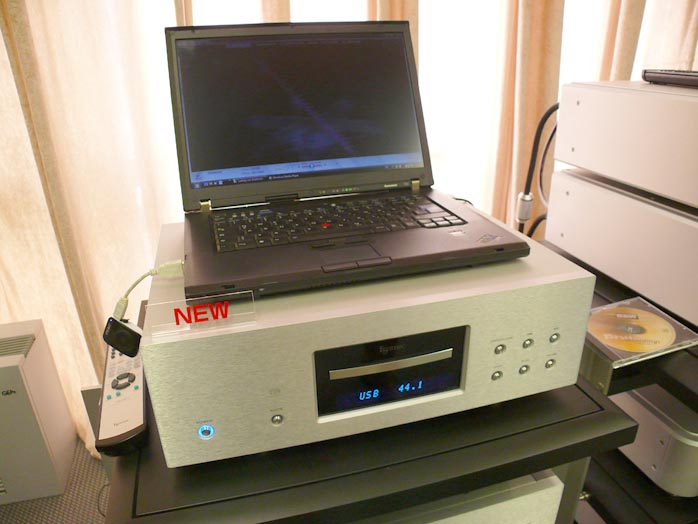 |
||||||
 |
||||||
Esoteric also bowed the new E-03 phono stage which Frederic Beudot will review for us. I requested the SA-50 to report on its USB capabilities in particular. |
||||||
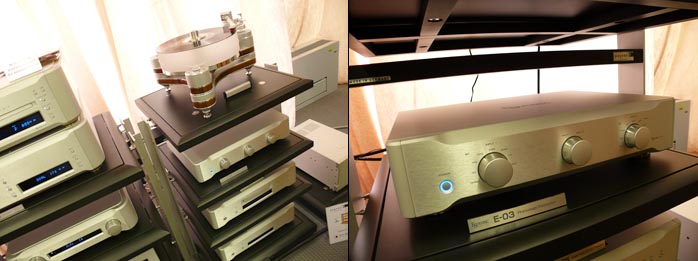 |
||||||
Here is a shot of the three grades of current Esoteric transports. It is only the corporate TEAC connection which allows Esoteric the privilege of dedicating so much time and emphasis on as endangered a species as purpose-designed music rather than PC spinners. |
||||||
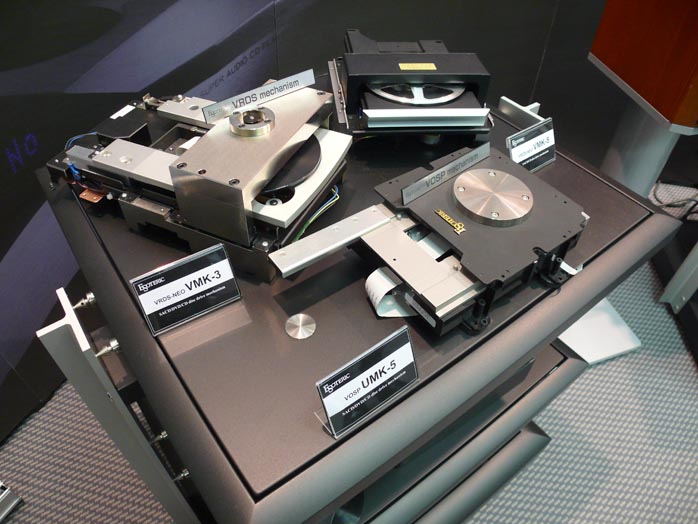 |
||||||
Over a brief cafeteria lunch to escape the hustle and bustle of their exhibit, I learned from company president Motoaki Ohmachi [left] and his second-in-command Kazutaka Tsuda that Japan had just gained its N°1 high-end audio store in Aristocrat which opened on 4-8-16 Minami Aoyama in the heart of Tokyo's most upscale shopping district. |
||||||
 |
||||||
Naturally, Esoteric is represented there - and with no less than four of their A-100 tube amplifiers in a bi-amp setup. |
||||||
 |
||||||
Depending on whom you asked, things ranged from very bad (one large US manufacturer had assembled a meeting of all his importers to literally beg for sales, admitting serious troubles) to "cyclical but survivable if one is properly positioned" to "things are going very well" if one was small, lean and mean and had neither palatial premises to support, a huge staff to keep busy nor a singular market that owned all one's turnover but instead was well diversified and adaptable. |
||||||
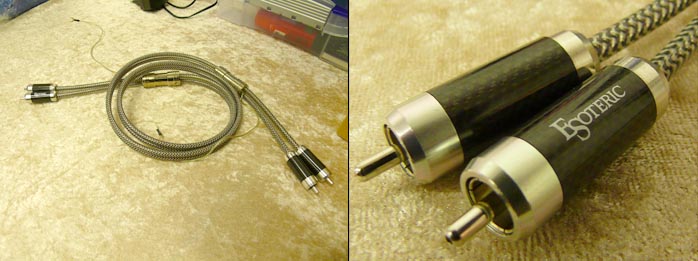 |
||||||
|
Esoteric's $2.200 8N phono cable with proprietary connectors. Only 300 sets were made.
Ohmachi-San put it this way. "We have been in business for a very long time. We made turntables with magnetic suspensions long before others. When Esoteric imports a brand to Japan, our customers are assured complete support and stability. They also rest assured that we have performed in-depth due diligence on their behalf." I thought of the APL Hifi venture which rebuilds Esoteric machines, one of which I own. With a scale of operations diametrically opposed to Esoteric's, Alex Peychev's outfit had looked seriously troubled (but seems to be back on track). While one wishes each small entrepreneur in this sector a rosy future, more than ever it is solid advice that customers contemplating acquisition of expensive to very expensive hifi machines consider the bigger picture to protect their investments. |
||||||
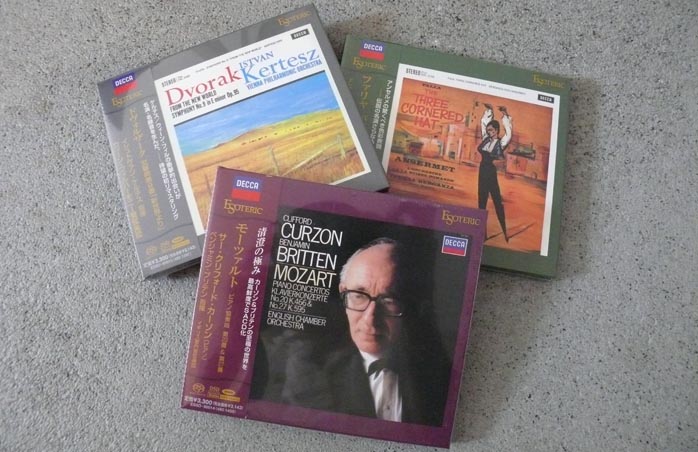 |
||||||
Ohmachi-San's love of music is no lip service as it is in so many "just about the music" hifi ads. He has issued a growing collection of classical music remasters on SACD and specially cut records where his quality control concerns limit each vinyl release to 1000. The last one sold out in just three short days. One of his dreams is to reissue a complete Wagner Ring cycle of 17 SACDs. "With the evidence of our short but expanding catalogue, the labels which hold the original master tapes of certain performances I'm interested in are becoming more open to consider working with us. During the remastering sessions, we of course use all our own machines and cables." Mark Gurvey interjected. "It's really Ohmachi-San's ears. If he ever loses his hearing, we might as well shut down." I pointed at Tsuda-San. "How about N°2 ears?" Everyone at the table cracked up. Returning to serious mode, I proposed a factory tour to Esoteric in conjunction with covering Japan's audio show in October. If the logistics work out, look for such coverage at the end of this year. |
||||||
 |
||||||
I was asked what I thought about the music server issue as exemplified by Linn, Meridian and Naim for example. I told Ohmachi-San and Kazutaka Tsuda that to my mind, Apple's iTunes interface had done a better job than any audio-only company stood a chance to improve upon cost-effectively. An $1,100 MacBook coupled to $100 each 1TB hard disks is the slickest cheapest solution extant. Where speciality audio companies should enter the picture is at the USB juncture. Esoteric's brass agreed. Until the whole scenario shakes out, with perhaps pure solid-state memory being the final destination, things in the sector are progressing too fast and audio companies are playing perennial catch-up. |
||||||
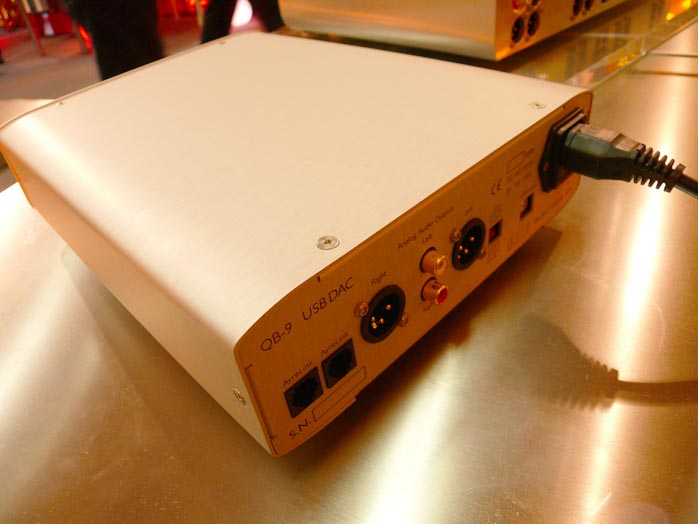 |
||||||
When it's no longer smaller boutique offerings like Charles Hansen's new Ayre QB-9 USB DAC but a big established corporate player like Esoteric which embraces USB as the delivery format for digital music for the time being, it seems fair to say that USB has finally arrived in earnest. I was chiding them for using a generic USB wire in their setup. As my recent review of Entreq's Crossword Discover cable showed, purpose-designed audio USB cables can make quite the difference. Of course Esoteric was well acquainted already with the concept. They simply hadn't had time yet to launch their own USB cable. For now, a standing ovation to Esoteric for listening to our and other reviewers who clamored for digital inputs including USB on their machines. Their SA-50 now sets that record straight. |
||||||
 |
 |
|||||
 |
||||||